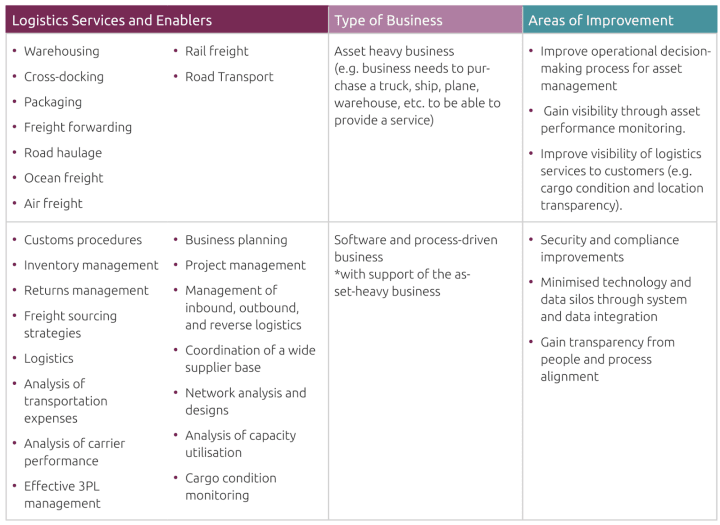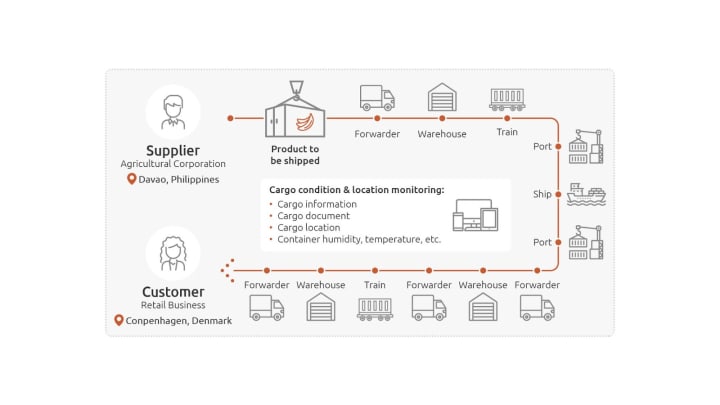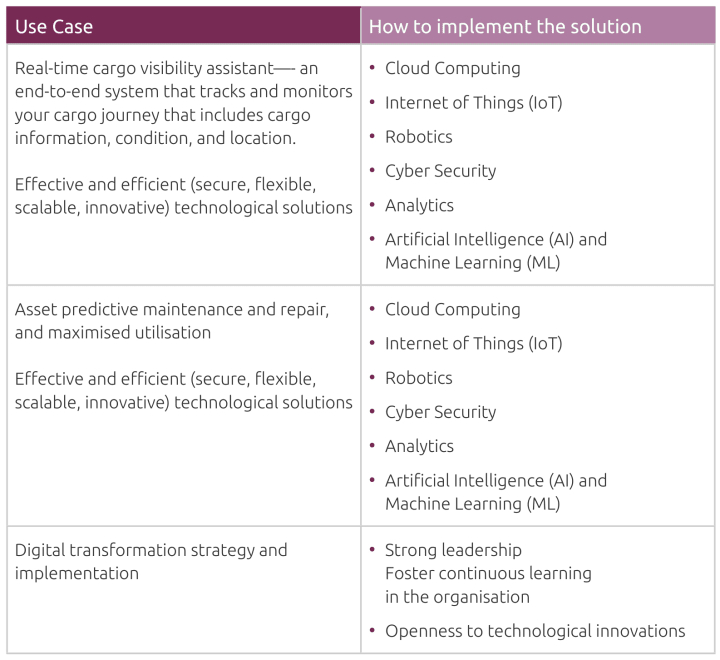Digital transformation and use cases in logistics
Michelle Anne Tabirao
on 25 April 2022
Tags: digital transformation , logistics , Open source
Customer-first culture is a driving force for any organisation’s success in logistics. Having a customer-first mindset means constantly thinking about your customer and your customers’ customers — and all of their employees. To have a good relationship with the customers, listening and understanding them is the key.
In the previous blog Customer centricity – the digital transformation driver in the logistics sector we shared and identified different parts of logistics that can be improved both from the customer and the logistic sector’s perspectives. Therefore, it is essential to strategise how to approach these challenges, identify the priorities, and create an organisational transformation to solve them. Solutions to the problems can range from multiple improvements or changes in the organisation’s people, processes, and technology.
There are multiple solutions to the challenges frequently seen in transport and logistics. How technology amplifies customer experience depends on how to maximise the solution’s capabilities. The four core areas typically faced in logistics are listed below, along with the key reasons why organisations need to initiate an appropriate strategy to address these areas that need improvements.
Digital transformation use cases in logistics
Table 1: Areas of improvements and the solution

Use cases 1, 2 and 3 below describe possible solutions to logistics sector challenges. Use case 1 is a real-time cargo visibility assistant, a customer-driven product that will solve customer-related issues. Use case 2 is asset predictive maintenance and repair for operating the assets. And lastly, use case 3 is an organisational solution and strategy about digital transformation in the logistics sector. All the use case 1, 2 and 3 should address some of the issues related to data silos and integration.
Use case 1: real-time cargo visibility assistant
There are multiple benefits to businesses and customers if they gain transparency into the supply chain, e.g., knowing the cargo condition and location. The customers can reduce demurrage costs, assess the efficiency of the logistics provider, and monitor cargo condition and quality during the time of transport. The logistics business will also benefit from solving the transparency problem, as they will also understand how to secure the cargo further and optimise the logistics process and operations.
The real-time cargo visibility assistant is an end-to-end system that tracks and monitors the cargo journey, including cargo information, condition, and location. The service includes sharing data with the customers in real-time. For example, Figure 1 below describes a supplier based in the Philippines who would like to export bananas to a retailer based in Copenhagen, Denmark. The cargo handling of bananas needs appropriate care in the whole transport and logistics leg. In addition, this cargo requires specific refrigeration temperature, moisture, and ventilation conditions. Otherwise, it will have a risk of premature spoilage. Therefore, the supplier can access a cargo visibility app. The app provides cargo information, location, and conditions, such as humidity and temperature.

This use case requires a high level of support for technological innovations, such as IoT, cloud computing, AI, and ML. In addition, this use case is also dependent on the asset utilisation and operation, such as trucking, warehouse, ports, train, air freight, on which the following use case will cover.
Use case 2: asset predictive maintenance and repair, and maximise utilisation
One of the solutions for creating better operational decisions for asset handling is to apply predictive analytics for maintenance and repair. Predictive maintenance uses data-driven, proactive maintenance methods designed to analyse the condition of equipment, which can then help predict maintenance and repair actions.
There are multiple assets used to run the operations in the logistics sector, such as warehouse equipment, road transport trucks, and spare parts. However, poor operational decisions on maintenance and repair can lead to this equipment not being fully utilised. The table below gives some examples of these assets and equipment.
Table 2: Logistics and sample assets needed to operate the service

In the trucking industry, predictive maintenance can help maintain and repair the trucks and their spare parts. Uptime of trucks is necessary to fulfil customer commitments in terms of delivery. On the other hand, trucking companies need to resolve the equipment issue and deliver reliable customer service as quickly as possible during the downtime of trucks on the roadside. This issue can lead to expensive repair, low-value maintenance work orders, and lengthy repair and diagnostics.
The fleet managers and technicians can proactively use dashboards and insights to prevent unexpected roadside breakdowns. Before a truck breakdown happens, they will receive notification for preventive maintenance and repair work. The implementation is through data collection from different sources, such as IoT data from truck and spare parts, truck purchase information, and historical work orders of maintenance and repair. Possible savings can be expected per asset when identifying pending failures is fixed before the servicing time of the trucks.
From a customer perspective, this solution can further fulfil customer expectations by ensuring the goods’ delivery on time.
User case 3: digital transformation and strategy implementation
Digital transformation is an excellent driving force so that use cases 1 and 2 shared in the previous section can be implemented. Digital transformation may require some of these technological implementations: Internet of Things (IoT), digital twin, IT automation, cyber security, cloud computing, analytics, Artificial Intelligence (AI), and Machine Learning (ML).
Transforming a business means a change in different parts of the company. This change can include business operations and customer-centricity goals.
Accelerating a digital transformation goal requires vision, resources, technology, and data:
- Defining the vision and goals is necessary to establish the culture of change
- Resources are needed to streamline its work to achieve customer excellence
- Technology and data is an innovative tool that drives transformation initiatives
- Data is the transformation accelerator that fuels intelligence, transparency, and understanding to the organisation’s past, present, and future endeavours
Multiple assessments are needed to define the vision, resources, technology, and data. First and foremost is to identify the organisation’s vision to establish possibilities, and this can be achieved by understanding and listening to the customers. These are possible guide questions: What are your customers saying about your organisation’s brand and solutions? How can you improve as an organisation? What are the current market trends and customer pain points? The second step is to have skilled resources to join the team in the transformation journey. Building a team includes assessing existing staff, realising if additional resources are required, and establishing a good work culture. The third step is being able to evaluate the technology. Once the current technological setup challenges are identified, the organisation can create a new technical landscape that supports the vision. The last step is to be able to use data for transformational needs. Organisations need to remove data silos, use data to inform product design and creation, use tools, such as analytics to analyse the current business landscape and predict future trends.
Digital transformation can be a game-changer for organisations that want to move from legacy to transformed businesses. However, success factors and definition of done needs to be defined appropriately. This activity will take some time for assessment, implementation, testing, and continuous iteration to be successful.
Use Case Implementation
Implementing the use cases described in the previous section requires multiple technological innovations. The table below illustrates the technologies that can help build the use cases. For example, the real-time cargo visibility assistant product will require various technical set-ups, well-working cloud computing technologies, high-level implementation of IoT, robotics, cyber security, and data-related solutions.
Table 3: Use case implementation

There are various ways to implement the solutions mentioned above. One of the ways is to use open source technologies in IT systems and infrastructure, cloud computing, IoT, AI, ML, robotics, analytics, cyber security and more.
Summary
Understanding the logistics sector’s improvement areas is very important as it has multiple benefits on customer excellence, business innovation, and operation. The use cases above describe various solutions to solve complex issues that logistics companies face. So, it is vital for logistics sector to use technological innovations and digital transformation to improve and continuously create value for its customers.
Find out how open source technologies can help you address your logistics challenges.
Read our whitepaper: Seeking satisfaction: Customer-centric digital transformation in logistics.
Canonical open source solutions
Full security coverage
Worry less about your open source software’s security vulnerabilities and bugs. Ubuntu Pro provides security patching for critical and high-severity Common Vulnerabilities and Exposures (CVEs) with ten years of security maintenance.
Bug fixing and troubleshooting
At Canonical, we offer direct 24/7 access to a world-class, enterprise open source support team through our web portal, knowledge base or by phone.
Full stack support
Open source your full stack with confidence. Canonical provides open source software support, which ensures a seamless experience from development to production.
The support includes data center, cloud, Ubuntu OS, kernel, containers, database, analytics and MLOps technology stack, observability and cloud-native applications.
Data Fabric Solutions
Unlock the potential of your data with an integrated, open source platform for applications and infrastructure. Canonical also offers enterprise solutions for data applications such as MongoDB, OpenSearch, Spark and Kafka.
Talk to us today
Interested in running Ubuntu in your organisation?
